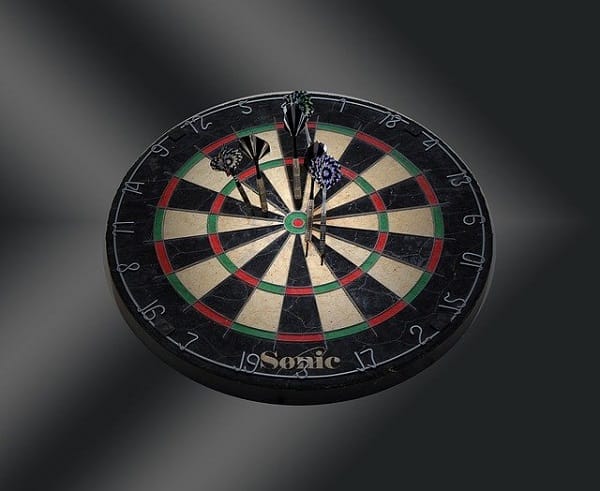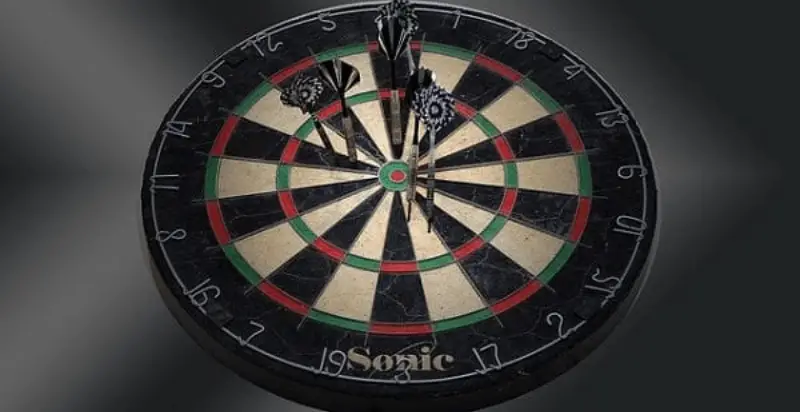Darts is one of the fastest-growing games in the world, with currently over ten million frequent players in the United States today. And now you want to join them?
We’re assuming you’ve bought your dartboard, some darts with super slick personalized flights and a brand new mahogany cabinet, you’re all ready to go! But… where are you going to put your dartboard?

Turns out… not just anywhere! Darts is a precision game with a set of official distance measurements sanctioned by bodies such as the World Darts Federation that operates in over 70 countries.
It’s not about getting as close as humanly possible, because where’s the satisfaction in making it easy for yourself? Get the envy of your fellow darts players by scoring bullseyes from outside the 7ft9 (and a quarter) minimum distance… and beyond!
First off, we’ll give you a quick summary of the basic distance requirements, followed by all the variations in American, Regional English and International darts regulations. That’s right, darts is a very diverse game!
So prepare to rack up a serious bragging score with your darts buddies when you next step up to the oche with our comprehensive list of dart regulations.
How Far Do I Have To Be From My Dartboard?
The standard height of the dartboard, measuring from the bullseye to the floor, is 5ft 8inches (173cm) if you are using the classic Bristle dartboard.
The official minimum distance between the front of the dartboard (not the side that is flush to the wall) and the throwline, also known as the ‘oche’, is 7ft 9.25inches (237cm). That quarter of an inch goes to show what a finely-calculated game darts really is!
The throwline or the ‘oche’ is the closest point the toe can be to the dartboard.
However, the key word here is ‘minimum’. You can go further than your allotted 7ft 9.25inches and, as you’ll see further down this article, many darts leagues often do. Why? Because it’s impressive!
Darts players are constantly wanting to increase their accuracy and throwing power, with players using an electronic dartboard throwing from around the 8ft mark.
So, now you know the official guidelines, it’s worth having a look at some of the variations on those rules within the darts world to see which game might suit your preferred darts style.
It All Depends On What Dartboard You’re Using
Contrary to popular belief, dartboards come in a few different shapes, colours and sizes and the type of dartboard often dictates the distance and height rules.
Each dartboard comes with its own specific measurements and once you become acquainted with each dartboard, you’ll know which specific measurement to use when you next break out the board for you and your friends.
The Bristle steel-tip dartboard, with its steel numbered frame and black, cream, red and green colour scheme, might be the one you have seen in bars or darts tournaments around the world.
The Bristle is the dartboard most preferred by the World Darts Federation and conforms to the aforementioned 5ft 8inch height and 7ft 9.25inch distance rule. Basically, it’s the dartboard against which all other dartboards are judged!
However, dartboards differ around the world and these varying designs reflect the culture to which they belong.
Countries such as Belgium have a very simplistic dart board with a plain six-ringed black, white and red colour scheme.
As mentioned previously, Bristle dartboards conform to the standard measurements, but there is one example where the height of the dartboard is actually a lot lower.
Wheelchair Measurements
Dart-playing wheelchair users actually have a natural height disadvantage in darts, as they are situated a lot lower to the ground than your average able-bodied darts player.
Due to its relative ease-of-play compared with other sports, darts has attracted a lot of players from the disability community.
In order to accommodate these wheelchair players, it was decided that the height of the dartboard should be lowered, but the distance between the player and the board should remain at 7ft 9.25 inches. But how did they decide on the adjusted height?
A disability support officer for Darts Australia deduced that during the 1920s, when the game of darts was first being formed, the average male darts player height was 5ft 8inch... the exact same height of the current regulation dart board!
So, calculating the average height of a wheelchair user, it was decided that the height for a dartboard in a disabled darts game should be 4ft 5inch, whilst the standard distance of 7ft 9.25inch between the board and the oche should remain the same.
Electronic Dartboards
Electronic dartboards are much more common in the USA than in other countries like the UK, where the sport is said to have originated but have yet to modernise from the standard Bristle dart board.
An electronic dart board has a slightly larger surface area than its Bristle counterpart, making it easier for soft-tip darts players to score.
Due to this increased radius, the distance between the dart board and the player has increased to 8ft (244cm), although the height of 5ft 8inches remains the same.
Electronic darts also allows you to compete with players from totally different countries via the internet!
If the average darts player can get over missing the thunk of metal into wood, the electronic darts might be the increase in difficulty more experienced darts players are looking for, whilst allowing you to compete on a global scale!
American Dartboards
The American style dart board has the same basic circular design of the Bristle, featuring numbers that ring around the edge.
However, the central ring positioned in the mid-point of the Bristle dartboard has been moved to the outer edges, and the outer bull has been removed completely, leaving a single red point bullseye in the centre. It has a red, blue and tan colour scheme.
The height of an American style dartboard is 5ft 3inch (160cm) from the floor to the centre of the bullseye, with the distance between the front of the board and the throwline being 7ft 3inch (221cm), comparatively shorter than the standard Bristle board.
So, those looking for a game that emphasizes accuracy might want to try the American style darts game!
English Regional Dartboards
England is rumoured to be the home of the modern darts game detailed above, but there are actually a few regional variations with their own distinctive boards and rules.
As the game developed in the late 19th and early 20th centuries, different parts of England came up with their own versions of the game, featuring Irish Black, Ipswich 5’s, Old Style London, London (Clock), Lincoln and Yorkshire dart boards.
All these dartboards are still played on today, although the London (Clock) style, with it’s two concentric rings and black, cream, red and green colour scheme is still the most popular.
The Irish Black and Lincolnshire dart boards have a very distinctive look, plain black with only one outer ring and a single bull, yet conform to the standard height of 5ft 8inches and the standard distance of 7ft 9inch between the front board and the player.
International Dartboards
There are over 70 countries that comprise the World Darts Federation, including a wide range of cultures and playing styles - from Asian nations like Japan, African countries such as Ethiopia and European countries like Belgium.
Belgium’s unique version of darts is called Vogelpik, and was popular in Flanders in around 1792, where players would try to use darts to spear a wooden board hung by wire from the mouth of a stuffed pigeon.
This Belgian dart board only has six rings, with certain points awarded to scoring in each. It has a basic red and white colour scheme with a black circle in the middle.
The dartboard is suspended on a wire 5ft 2inch (158.48cm) from the floor and the distance between the player and the board is 6ft (182.88cm). This is the shortest regulation height and distance we have seen so far.
Conclusion
As we have seen, darts is far from being a one-board, one-person game and has numerous variations on the sport that find their origins in numerous countries and cultures.
However, if you are looking to set up a standard World Darts Federation-approved game in your kitchen or living room (although maybe look to cover the walls first) then you’ll want to have 5ft 8inches between the floor and your bullseye and 7ft 9.25inches between you and the front of the board.
But for the more eccentric darts connoisseur, this breakdown of different dartboards and their corresponding regulations will certainly impress your dart-playing pals before your toe even touches the oche!
Whether it’s the more intricate English regional rules, the simpler American style or the outright easy Belgian dartboards, you can experiment with these different playing styles and hopefully find one that will improve your darts skills or simply allow you to get a lot more enjoyment out of the game!

I’m Lia and I love playing games. I started this site to share things with friends and they encouraged me to post more and now I’m trying to share things with the world – indoor and outdoor sports, and board and bar games. I write about things like Bocce, Croquet, Billiards, Darts and other fun ways to enjoy time with your friends and family!


